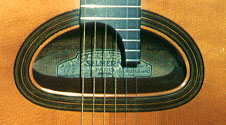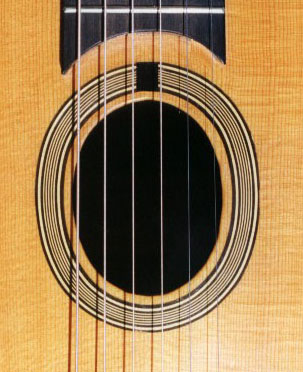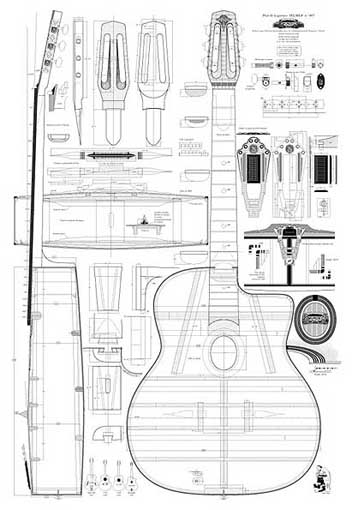吉他英雄
UID293755
好友
回帖0
主题
精华
积分8307
阅读权限255
注册时间2006-7-24
最后登录1970-1-1
在线时间 小时
|
[size=+2]Some background and observations about
[size=+2]the main Selmer six-string guitar modelsA small attempt at putting into words some thoughts about these guitars for the benefit of those who have yet to spend much time with them.  
The Maccaferri model, with the large D-shaped soundhole, was originally designed to accommodate Mario Maccaferri's patented Internal Resonator. In many cases however, it seems that the guitar worked better for players without that resonator, as few original Selmers retain one. We believe this is due to a production error that caused them to come loose and buzz, provoking their prompt and sometime brutal removal. That said, the basic 1932-33 D-hole guitar has 12 frets and a 648mm (25.5") scale, very similar to our contemporary Martin/Gibson/Fender scales, with a "classical-width" fingerboard. Necks on the early Selmers were generally quite large. The few with maple bodies had maple necks, generally all other necks were walnut.
 The later Selmer model, with the small vertical oval soundhole, never had a resonator; in fact, it was a design repudiation of the resonator model. Around late 1933, after a handful of transitional models, it was offered with the longer 670mm (26.4") scale. Once it was available, this was the model that Django really played. Almost all Selmers ever made are this model. Virtually all Selmer guitars, early and late, were of laminated Indian rosewood with walnut necks. There exist a few very late ones with solid rosewood necks and a few rare all-mahogany or birdseye maple guitars with matching maple necks. Selmer tops were always solid spruce. In terms of sound, the models differ more to the player than to the listener. Because of how the soundhole affects the way the sound emanates from the guitar's body, the player hears perhaps more accurately what the D-hole model sounds like to others. By contrast, with its small soundhole, the oval-hole model seems to project more directionally. It's generally agreed that the longer scale on the oval-hole model allows it to be played harder as well. By far the most important element in a guitar's sound (besides the player!) is the top. All Selmer models had solid French spruce tops. The tonewoods of the body certainly color that sound, and these tonal differences are again more evident to the player than to the listener. To most players familiar with the tonal contrast of a normal American-style flattop and a normal American-style archtop, the Selmer-style guitars define a third point on a triangle - as different from the former two as they are from each other. First impressions are generally that they sound "trebly," but it should be noted that the style of playing these guitars is fundamentally different- particularly with the oval-hole model - than what is usually employed playing more conventional flattop and archtop instruments. Once the picking hand's "sweet spot" is found, the full dynamic range appears. The later Selmer model, with the small vertical oval soundhole, never had a resonator; in fact, it was a design repudiation of the resonator model. Around late 1933, after a handful of transitional models, it was offered with the longer 670mm (26.4") scale. Once it was available, this was the model that Django really played. Almost all Selmers ever made are this model. Virtually all Selmer guitars, early and late, were of laminated Indian rosewood with walnut necks. There exist a few very late ones with solid rosewood necks and a few rare all-mahogany or birdseye maple guitars with matching maple necks. Selmer tops were always solid spruce. In terms of sound, the models differ more to the player than to the listener. Because of how the soundhole affects the way the sound emanates from the guitar's body, the player hears perhaps more accurately what the D-hole model sounds like to others. By contrast, with its small soundhole, the oval-hole model seems to project more directionally. It's generally agreed that the longer scale on the oval-hole model allows it to be played harder as well. By far the most important element in a guitar's sound (besides the player!) is the top. All Selmer models had solid French spruce tops. The tonewoods of the body certainly color that sound, and these tonal differences are again more evident to the player than to the listener. To most players familiar with the tonal contrast of a normal American-style flattop and a normal American-style archtop, the Selmer-style guitars define a third point on a triangle - as different from the former two as they are from each other. First impressions are generally that they sound "trebly," but it should be noted that the style of playing these guitars is fundamentally different- particularly with the oval-hole model - than what is usually employed playing more conventional flattop and archtop instruments. Once the picking hand's "sweet spot" is found, the full dynamic range appears.  These guitars are traditionally played with Argentine strings, a rather light, special composition string - silver-plated copper over a steel core - made in France. They are also often played with rather high action, for clearer notes and better vibrato. American silk-and-steel and bronze strings emphatically do not work, regular steel strings are merely acceptable. There is, however, one American stringmaker offering a superior string for these guitars, called Manouche-Tone Strings. The Maccaferri classical guitar is tonally much more akin to other nylon-strung guitars (of course in the early 1930s, there were only gut strings) because it has a fan-braced top and a relatively conventional glued-on bridge. Its cutaway, coupled with its unique voice, make it an extraordinary choice not only for classical playing (for which Mario Maccaferri designed it, and played himself so beautifully) but for Brazilian music, jazz and myriad other applications. Of the two steelstring models, three out of four modern buyers initially prefer the oval-hole, mostly because it's what Django played. Many players who know absolutely nothing of Django (believe it or not, such people do exist!) gravitate instead toward the D-hole. These tend to be either classical players or folks who've basically always played jazz electrics. The Internal Resonator, when it works correctly, has a profound and very salutary effect on the tone. It does not increase the volume but one apt description is that it acts as a bass reflex, altering the EQ of the guitar. There were two main resonator designs in the early Selmer days: one with a single opening which worked, and another, with two small holes, that didn't. Because of Mario Maccaferri's brief tenure with Selmer, few of either design were ever really built, far fewer survived. The Internal Resonator is a great deal of trouble to make and install, but well worth it. These guitars are traditionally played with Argentine strings, a rather light, special composition string - silver-plated copper over a steel core - made in France. They are also often played with rather high action, for clearer notes and better vibrato. American silk-and-steel and bronze strings emphatically do not work, regular steel strings are merely acceptable. There is, however, one American stringmaker offering a superior string for these guitars, called Manouche-Tone Strings. The Maccaferri classical guitar is tonally much more akin to other nylon-strung guitars (of course in the early 1930s, there were only gut strings) because it has a fan-braced top and a relatively conventional glued-on bridge. Its cutaway, coupled with its unique voice, make it an extraordinary choice not only for classical playing (for which Mario Maccaferri designed it, and played himself so beautifully) but for Brazilian music, jazz and myriad other applications. Of the two steelstring models, three out of four modern buyers initially prefer the oval-hole, mostly because it's what Django played. Many players who know absolutely nothing of Django (believe it or not, such people do exist!) gravitate instead toward the D-hole. These tend to be either classical players or folks who've basically always played jazz electrics. The Internal Resonator, when it works correctly, has a profound and very salutary effect on the tone. It does not increase the volume but one apt description is that it acts as a bass reflex, altering the EQ of the guitar. There were two main resonator designs in the early Selmer days: one with a single opening which worked, and another, with two small holes, that didn't. Because of Mario Maccaferri's brief tenure with Selmer, few of either design were ever really built, far fewer survived. The Internal Resonator is a great deal of trouble to make and install, but well worth it.
- Paul Hostetter
 |
|
